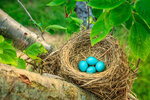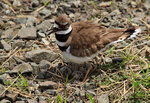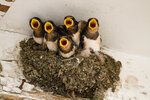




It’s the breeding season for all our bird neighbors and that means there are nests and eggs all around us. But where are they? Some are easily found, for example the mud nest of the Barn Swallow. But most are well hidden since nest predation is a constant threat.
The size and shape of nests seems to be instinctive; the appearance and location of a nest, even when the bird is absent, can help to identify the nesting species. Our robins build their nests of woven grasses, usually stuck together with mud and hidden in the interior of leafy trees. Their strong construction means that they often remain in place and thus are commonly seen in the fall when the leaves, and the robins, have departed.
Of course, the larger birds, especially the hawks, ospreys and eagles, feel no need to hide their stick nests. These nest locations are used over multiple years and sometimes build up to a huge nest. They are so large that they are easily seen as you drive along the highway.
Finally, the nests of some birds are really just a scrape on the ground. An example is the Killdeer, now nesting in open areas throughout Thurston County. Their eggs are protected by cryptic coloration, mottled brown spots and stripes that help the eggs, usually four in number, blend in with their surroundings.
Birds are the only animal that produces hard-shelled eggs. Reptile eggs are leathery and flexible, and since dinosaurs are the ancestors of both birds and reptiles, this has led to some debate about the nature of dinosaur eggs. Because chicken eggs are such a common element of our everyday life and diet, you may well think you know all there is to know about birds’ eggs. I certainly thought so, before I began researching this column.
When breeding season comes, birds undergo changes – their gonads swell and begin to produce sperm and eggs. A female’s ovary (for most species, there is only one) is connected to a tube called the cloaca. The cloaca has multiple purposes, functioning as the body’s exit for digestion, urinary and reproductive actions. (Physically, males are similar).
Mating occurs when the pair touch cloaca and the male deposits sperm into the female. The process after this act varies with species, but generally, the female is able to store viable sperm adjacent to her cloaca until needed. Now the interesting part begins.
Likely every reader is familiar with the parts of an egg, both in its fresh and hardboiled condition. There’s the yolk, the white, the shell and a thin membrane inside the shell. In bird reproduction, there are these and a few additional parts of an egg, and each has a vital role.
A bird’s egg starts as a single cell and, under hormonal influence, increases in size somewhat and gains a yolk sac. After fertilization (or even unfertilized as in many domestic chickens), it starts its trip down the oviduct (the upper part of the cloaca). Then egg membranes and albumin (proteins) are added.
The developing egg is hydrated and molded in its characteristic shape. Calcium is deposited on the outer membrane, forming the shell. As the egg proceeds down the oviduct, there are color-producing glands that, if activated, will color the outer surface of the egg. Then the female lays the egg into its nest.
The size and shaping of eggs are highly variable. Generally, large birds produce larger eggs with thicker shells and a greater yolk supply to feed the growing chick. And, more remarkable, some of the seabirds produce eggs in a pyramidal shape which prevents rolling off the nesting cliffs.
The color glands produce only two colors, blue and brown, but these colors combine to create an almost unending variety of colors and patterns. It seems that much of egg color is inherited – for example, all the thrushes, including robins and bluebirds) lay blue eggs. Some researchers, however, argue that color is flexible. Most cavity nesting birds have white eggs, which are more visible in the dark cavity. Bluebirds are cavity nesters, but they lay blue eggs (I can attest to that). However, in the last two decades more and more Eastern Bluebirds and been laying white eggs. So, perhaps there is some flexibility.
If one thinks about it, the egg-laying activity (despite the fact that chickens excel at it) is not simple at all. In fact, it’s absolutely amazing. Consider, for example, our Barn Swallow. This bird weighs about 7/10th of an oz. Yet this tiny swallow female manages to produce 5-6 eggs in as many days. Such a biological demand on her small body is almost unimaginable for us humans, yet she manages it. (And, incidentally, she manages this physical feat after migrating from Central or South America just a month or two ago).
The female breeding birds all around us are managing similar feats. How, for example, do these females manage to acquire all the calcium required to make all these eggs? Must be some calcium in all those insects that the swallow manages to capture daily.
When I was tending bluebird boxes, I witnessed an interesting sight. The female was on the nest, and just as the hatching was occurring, she was eating the eggshells. Possibly, that explains why, with all the egg hatching going on all around us, we seldom encounter eggshells.
Just another reason our avian neighbors demand our curiosity and respect.
George Walter is environmental program manager at the Nisqually Indian Tribe’s natural resources department; he also has a 40+ year interest in bird watching. He may be reached at george@theJOLTnews.com
Photos for most of my columns are provided by Liam Hutcheson, a 15-year-old Olympia area birder and avid photographer. Liam specializes in taking photos of identification and not nesting activities. For this column, I have relied on photos from other sources.
4 comments on this item Please log in to comment by clicking here
PegGerdes
Astonishing. Thank you for consolidating research and observation into this fascinating article.
Friday, June 2, 2023 Report this
Love your column, George. Birds are an increasing source of wonderment the more I learn about them.
Friday, June 2, 2023 Report this
Callie
If you ever get to Eastern Pennsylvania, there is a bird-nest museum at Bowman's Tower Nature Preserve. Extraordinary variety of nests in the collection.
Saturday, June 3, 2023 Report this
Georgewalter
Thinking about nest collections, there is also a very good bird egg collection at the Slater Natural History Museum at the University of Puget Sound in Tacoma. It includes a number of Western Bluebird nests that I collected when I was monitoring JBLM bluebird boxes
Sunday, June 4, 2023 Report this